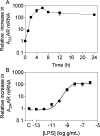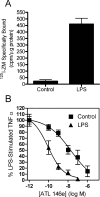Lipopolysaccharide rapidly modifies adenosine receptor transcripts in murine and human macrophages: role of NF-kappaB in A(2A) adenosine receptor induction
- PMID: 16022683
- PMCID: PMC1276958
- DOI: 10.1042/BJ20050888
Lipopolysaccharide rapidly modifies adenosine receptor transcripts in murine and human macrophages: role of NF-kappaB in A(2A) adenosine receptor induction
Abstract
The A(2A) adenosine receptor (A(2A)AR) mediates anti-inflammatory actions of adenosine in a variety of cell types. LPS (lipopolysaccharide) was reported to induce a small (<2-fold) increase in the expression of A(2A)AR mRNA in human monocytes and monocytic cell lines. We investigated the effects of LPS on the expression of adenosine receptor mRNAs in primary mouse IPMPhi (intraperitoneal macrophages), human macrophages and Wehi-3 cells. Treatment with 10 ng/ml LPS for 4 h produced a >100-fold increase in A(2A)AR mRNA. LPS-induced increases in mRNA for A(2A)AR and TNFalpha (tumour necrosis factor alpha) are reduced by 90% in IPMPhi pretreated with the NF-kappaB (nuclear factor kappaB) inhibitor, BAY 11-7082 {(E)3-[(4-methylphenyl)sulphonyl]-2-propenenitrile; 10 microM}. In Wehi-3 cells exposed to LPS, A(2A)AR and A(2B)AR transcripts are elevated by 290- and 10-fold respectively, the A(1)AR transcript is unchanged and the A(3)AR transcript is decreased by 67%. The induction of A(2A)AR mRNA by LPS is detectable after 1 h, reaches a peak at 6 h at 600 times control and remains elevated beyond 24 h. The ED50 (effective dose) of LPS is 2.3 ng/ml. A(2A)AR receptor number, measured by 125I-ZM241385 binding to whole cells, is undetectable in naïve cells and increases linearly at a rate of 23 receptors x cell(-1) x min(-1) to a B(max) of 348 fmol/mg (28000 receptors/cell) in 20 h. The increase in receptor number is correlated with an increase in the potency of an A(2A) agonist (4-{3-[6-amino-9-(5-ethylcarbamoyl-3,4-dihydroxy-tetrahydro-furan-2-yl)-9H-purin-2-yl]-prop-2-ynyl}-cyclohexanecarboxylic acid methyl ester; referred to as ATL146e) to stimulate cAMP in these cells. After LPS pretreatment, the potency of the A(2A) agonist, ATL146e, to reduce TNFalpha release from IPMPhi was increased by 200-fold. The results support the hypothesis that regulation of adenosine receptor expression, especially up-regulation of the A(2A)AR, is part of a delayed feedback mechanism initiated through NF-kappaB to terminate the activation of human and mouse macrophages.
Figures




References
-
- Ohta A., Sitkovsky M. Role of G-protein-coupled adenosine receptors in downregulation of inflammation and protection from tissue damage. Nature (London) 2001;414:916–920. - PubMed
-
- Zimmermann H. Extracellular metabolism of ATP and other nucleotides. Naunyn-Schmiedebergs Arch. Pharmacol. 2000;362:299–309. - PubMed
-
- Link A. A., Kino T., Worth J. A., McGuire J. L., Crane M. L., Chrousos G. P., Wilder R. L., Elenkov I. J. Ligand-activation of the adenosine A2a receptors inhibits IL-12 production by human monocytes. J. Immunol. 2000;164:436–442. - PubMed
Publication types
MeSH terms
Substances
Grants and funding
LinkOut - more resources
Full Text Sources
Research Materials
Miscellaneous

